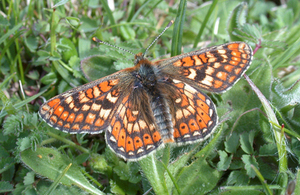Improvement programme for England’s Natura 2000 sites: new report
Report on how to improve Natura 2000 sites in England published.

The Culm Grasslands Special Area of Conservation supports the largesr population of marsh fritillary butterfly in the UK
A report published by Natural England’s improvement programme for England’s Natura 2000 sites (IPENS) project sets out a blueprint for the long-term management of 338 of England’s important nature sites.
Natura 2000 is a European designation (including Special Protection Areas and Special Areas of Conservation ) that protects important natural habitats and species. Natura 2000 sites include some of the country’s most familiar landscapes including the Northumberland coast, the New Forest, the Norfolk Broads and Salisbury Plain.
There are 338 Natura 2000 sites in England, in both marine and terrestrial locations, covering more than 2 million hectares. These are sites that have been designated either as a Special Protection Area due to the rare, vulnerable or migratory birds present or as a Special Area of Conservation, which protect a variety of wild animals, plants and habitats. Where these are on land they are also notified as Sites of Special Scientific Interest.
Many Natura 2000 sites are being adequately conserved and meet their conservation objectives. However, others are not yet in a healthy state due to a number of pressures. The 2-year IPENS project involved more than 650 different organisations and has significantly improved the understanding of what needs to be done to protect and enhance the Natura 2000 network in England.
This is the first time that this information has been drawn together for all of England’s Natura 2000 sites.
The achievements of the project so far have included:
- producing a site improvement plan for each Natura 2000 network site
- developing strategic plans to address issues that affect multiple sites
- outlining priority actions needed to achieve favourable conditions
- identifying gaps in Natura 2000 evidence
A site improvement plan has been produced covering every Natura 2000 site in England. The plans present the best available evidence in support of actions required to achieve and maintain sites in a good condition. More than 3,000 specific actions have been identified in the individual plans.
Dr Andy Clements, Natural England Board Member and Director of the British Trust for Ornithology, said:
England has a diverse range of habitats resulting in a wonderfully rich and varied wildlife. The IPENS project has enabled Natural England, the Environment Agency and other partners to more effectively target our conservation efforts on Natura 2000 network sites and surrounding areas.
A wide range of organisations and individuals own, manage or have an interest in England’s Natura 2000 sites. This includes government agencies, voluntary bodies, private companies and individuals and collectively there is a wealth of knowledge, experience and interest in Natura 2000. We are grateful to everyone who has been involved with this important and far reaching project.
By drawing together information for the complete set of marine and terrestrial Natura 2000 network sites in England, the project has given decision-makers a much improved understanding of the priority actions required to improve the condition of England’s sites, including who might help make this a reality and how.
The evidence produced by the IPENS project team supports the Biodiversity 2020 strategy for England’s wildlife and ecosystem services. The strategy was published in 2011 and sets out the government’s ambition to halt overall loss of England’s biodiversity by 2020, support healthy well functioning ecosystems and establish coherent ecological networks; with more and better places for nature for the benefit of wildlife and people.
The improvement programme for England’s Natura 2000 project was supported by EU LIFE+ funding and was run by Natural England in partnership with the Environment Agency.
The summary report from the IPENS project is available for download from the Natural England publications catalogue. The IPENS report has been published to coincide with European Natura 2000 Day Thursday 21 May 2015.